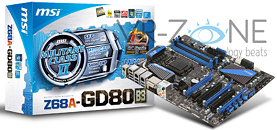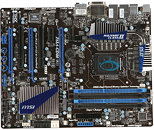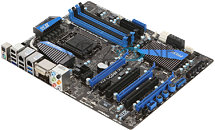- Joined
- Oct 9, 2007
- Messages
- 47,878 (7.38/day)
- Location
- Dublin, Ireland
| System Name | RBMK-1000 |
|---|---|
| Processor | AMD Ryzen 7 5700G |
| Motherboard | Gigabyte B550 AORUS Elite V2 |
| Cooling | DeepCool Gammax L240 V2 |
| Memory | 2x 16GB DDR4-3200 |
| Video Card(s) | Galax RTX 4070 Ti EX |
| Storage | Samsung 990 1TB |
| Display(s) | BenQ 1440p 60 Hz 27-inch |
| Case | Corsair Carbide 100R |
| Audio Device(s) | ASUS SupremeFX S1220A |
| Power Supply | Cooler Master MWE Gold 650W |
| Mouse | ASUS ROG Strix Impact |
| Keyboard | Gamdias Hermes E2 |
| Software | Windows 11 Pro |
Here are the first pictures of MSI Z68A-GD80 (B3), the company's first socket LGA1155 motherboard based on Intel's new Z68 PCH. Intel is weeks away from launching the Z68 PCH, which is a middle-ground between P67 and H67. P67 let you overclock, while it didn't feature Flexible Display Interface (FDI); H67 featured FDI, but didn't let you overclock. Z68 features FDI, it also lets you overclock to the potential of P67. MSI's Z68A-GD80 makes use of the B3 revision of the Z68 PCH. It intends to offer loads of overclocking features, ample discrete GPU expansion, as well as FDI connectivity to let you use the processor-embedded graphics.
The LGA1155 socket supports 2011 Core i5/i7 "Sandy Bridge" processors. The LOTES-made socket on the Z68A-GD80 is powered by a 15-phase VRM that uses "solid-state" chokes that don't buzz on load. The VRM is cooled by two heatsinks that share heat over a heat pipe. The socket is wired to four DDR3 DIMM slots that support dual-channel memory. Expansion slots include three PCI-Express x16 (electrical x16/NC/x4 or x8/x8/x4), two PCI-E x1, and two PCI.



Storage connectivity includes four SATA 3 Gb/s ports, three SATA 6 Gb/s ports (two from PCH, one from a 3rd party controller), and one eSATA 6 Gb/s. FDI display connectivity includes DVI and HDMI. Other connectivity features include 8-channel HD audio, USB 3.0 (two rear-panel, two by internal header), dual gigabit Ethernet, USB 2.0, and FireWire.
Overclocker-friendly features include OC Genie 2, memory optimizer technology, auxiliary 6-pin power input for additional electrical stability, consolidated voltage measure points, and likely a feature-rich BIOS.
View at TechPowerUp Main Site
The LGA1155 socket supports 2011 Core i5/i7 "Sandy Bridge" processors. The LOTES-made socket on the Z68A-GD80 is powered by a 15-phase VRM that uses "solid-state" chokes that don't buzz on load. The VRM is cooled by two heatsinks that share heat over a heat pipe. The socket is wired to four DDR3 DIMM slots that support dual-channel memory. Expansion slots include three PCI-Express x16 (electrical x16/NC/x4 or x8/x8/x4), two PCI-E x1, and two PCI.



Storage connectivity includes four SATA 3 Gb/s ports, three SATA 6 Gb/s ports (two from PCH, one from a 3rd party controller), and one eSATA 6 Gb/s. FDI display connectivity includes DVI and HDMI. Other connectivity features include 8-channel HD audio, USB 3.0 (two rear-panel, two by internal header), dual gigabit Ethernet, USB 2.0, and FireWire.
Overclocker-friendly features include OC Genie 2, memory optimizer technology, auxiliary 6-pin power input for additional electrical stability, consolidated voltage measure points, and likely a feature-rich BIOS.
View at TechPowerUp Main Site



 on the factor that the Volt measure points are probably going to be covered up due to the 24pin..
on the factor that the Volt measure points are probably going to be covered up due to the 24pin..




